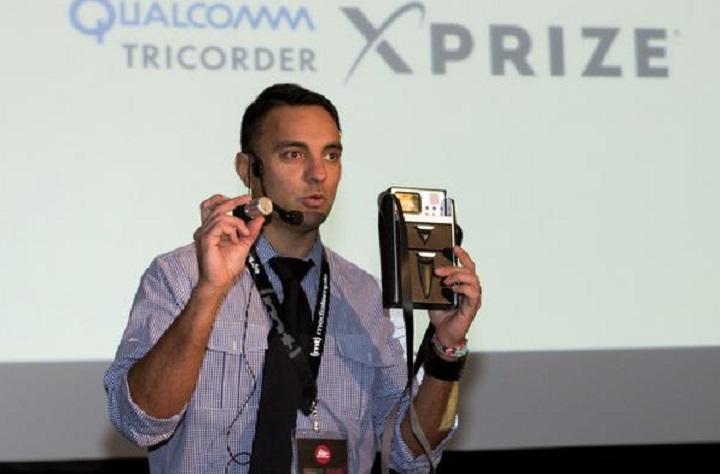
1. Tricorders
In Star Trek: The Original Series, Dr. McCoy — nicknamed “Bones” — carried around a device called a tricorder that could record and relay medical information. This cool fictional technology is on its way to becoming a reality, thanks to Qualcomm’s $10 million XPrize competition.
For the past five years, teams from the U.S., U.K., Canada, India, and Taiwan have been competing to develop functional tricorders. The device would be able to diagnose 13 health conditions and 5 real-time vital signs such as blood pressure.
On April 12, 2017, the winners of the competition were announced: Final Frontier Medical Devices came first, receiving $2.5 million while Dynamical Biomarkers Group came in second, receiving $1 million. With the winners announced, it is hoped that they will work towards improving their prototypes and go into wide public distribution so that, eventually, individuals will have their own tricorders to check and manage their health without frequent trips to the hospital or doctor’s office.
2. (CAR) T-cell Immunotherapies
Cancer research has come a long way. For example, tremendous advancements have been made in treatments for blood cancers like leukemia and lymphoma — so much so that the survival rate for children with Acute Lymphocytic Leukemia (ALL) is now over 85%. Starting in 2017, these numbers have the chance of rising.
Pending approval from the FDA, chimeric antigen receptor (CAR) T-cell therapy could be available at cancer centres for the first time ever in the United States. The therapy involves extracting white blood cells called T-cells from the patient and treating the T-cells in a special laboratory. After the T-cells are treated, it is then returned to the patient to help fight cancer cells. The clinical trials of this kind of cellular immunotherapy done on kids with ALL have reported high success rates of complete remission. Besides treating ALL, the Leukemia & Lymphoma Society also noted that CAR T-cell therapy have the potential in treating multiple myeloma, chronic lymphocytic leukemia (CLL), and some types of non-Hodgkin lymphoma (NHL).
3. Augmented Reality
Augmented reality (AR) is when a computer digitally enhances the sights and sounds of real-life environments. It may sound fancy and difficult to achieve, but millions of people across the globe has already gotten some experience with AR thanks to the popular Nintendo mobile game Pokemon Go.
Besides fun video games, AR is also incredibly useful in the healthcare industry. For example, AccuVein uses AR technologies in order to map out a patient’s vein for phlebotomists and nurses. In 2017, AR technologies is expected to be even more prominent in the medical field, as it:
- Informs doctors and medical students how to execute certain surgeries, procedures, and/or dissections
- Helps patients with the conceptualization of their conditions, treatments, surgeries, and recoveries
- Map out locations of health care providers as well as life-saving equipments — such as defibrillators — for the public in case of emergency
Additionally — though it will be many years before they are a reality — research are currently being conducted using AR implants for the eyes and ears. Major tech companies such as Google and Samsung have already filed patents for lens implants made to monitor glaucoma and emit medicines.
4. Synthetic Blood
Thanks to technological advancements and incredible medical research, we have figured out how to replace almost any part of the human body — from prosthetic limbs and ear implants to artificial hearts and pacemakers. A recent addition to such a list is blood.
In 2017, England’s National Health Service (NHS) will begin to conduct early safety trials for synthetic blood. The trial includes giving small amounts of synthetic blood made from stem cells to about 20 people. The short-term goal for synthetic blood is to treat illnesses and other blood conditions, such as sickle cell anemia. When it comes to long-term, NHS scientists are hoping that synthetic blood will be the answer for blood transfusions to those with more rare blood types.
5. Mobile Stroke Treatment Units
When a stroke occurs, about two million neurons are lost in the brain every minute after the event. Thus, the longer you remain untreated after a stroke, the worse the damage can be to your brain. That’s why a Mobile Stroke Treatment Unit (MSTU or MSU) can essentially help save a number of lives.
Made up of paramedics, a nurse, and a medical imaging specialist — amongst other emergency personnel — a MSTU is basically an ambulance full of health care professionals dedicated to treat and diagnose strokes in a quick and timely manner. When a dispatcher calls in a stroke, the MSTU will rush to the patient’s home and then determine if the stroke is caused by a blood clot. If it is, the MSTU will inject a drug to dissolve the clot in the patient, then bring them to a hospital.
Response time holds promise, according to early MSTUs. There are currently MSTUs in major cities such as Cleveland, New York, Houston, and Denver. By late 2017, it is expected that an MSTU will be available and working in about 40% of major-city hospital emergencies, according to a source.
6. Interoperability
Interoperability is the ability for healthcare information technologies to communicate with each other. It is one of the most highly-anticipated technological advancements for medical experts as it creates an easier way to transfer healthcare informations.
First Healthcare Interoperability Resources (FHIR), a program that improves the speed and efficiency of the transferal of health data thereby saving lives and money, is set to be released in 2017. Instead of transferring entire documents, which can cause a backup in the system, the FHIR is able to transfer specific healthcare information from one place to another (ie. from your doctor to the billing department). As a result, healthcare workers won’t have to shift through a bunch of additional information to get the data they want/need. This is creates more efficient patient care and experience, as well as make records more accurate.
The FHIR can make it easier to create health apps.
7. Ultrasound Therapy for Alzheimer’s Disease
Currently, 1 in 3 seniors will die with Alzheimer’s or another form of dementia; and Alzheimer’s is the 6th leading cause of death in the United States, according to Alzheimer’s Association. While there is no cure, some treatments have been developed to help manage the disease. One promising treatment is about to begin human trials in 2017: ultrasound therapy on amyloid plaques. Amyloid plaques cluster around the brain’s neurons, and are believed to contribute to Alzheimer’s.
The study began in 2015, when Australian researchers found out that sound waves generated by ultrasounds cleared the amyloid plaques in mice. After the amyloid plaques were cleared, about 75% of the mice performed better on memory tests. Not only did the mice have better memory, the ultrasound did not cause any damage to surrounding tissue and can be much cheaper than other drugs that perform similar things, according to The Wall Street Journal. While duplicating the same results would be more difficult in humans, researchers are hopeful about the treatment trials in 2017.
Featured Image: twitter









